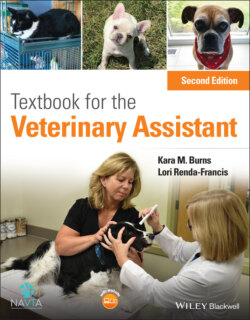Читать книгу Textbook for the Veterinary Assistant - Lori Renda-Francis - Страница 62
Restraint
ОглавлениеWhen restraint of a cat is indicated, one of the best tools for the health‐care team to have readily available is a large towel, which can be used to wrap the cat’s body securely (Figure 4.7). It also allows for wrapping, and thus controlling, the cat’s body, feet, and claws. For femoral or cephalic vein exposure, or if an IM injection is warranted, a front or back leg can be held outside the towel wrap. Also, the towel wrap restraint allows for oral or ophthalmic medications to be given without risk of the cat scratching a health‐care team member. Some health‐care teams have found that simply covering the head of the cat (paying careful attention to insure the cat can breathe) calms the cat down and enables them to perform procedures. Whichever method is used, insure that all team members involved are in agreement with the restraint plan.
Another tool that is very beneficial when cat restraint is needed is the cat bag or feline restraint bag (Figure 4.8). The cat bag should be make of a heavy canvas or nylon material and have a zipper or Velcro closure. The bag has openings for the cat’s front and rear legs so one limb at a time can be removed for procedures. As cats come in all sizes, a variety of bag sizes are available. Health‐care team members should never leave a cat in a feline restraint bag unattended because the cat can easily roll off the table. When it is time to remove a cat from the feline restraint bag, the whole team must be alert and prepared. To remove the cat, the bag closure should be undone, and then the neck strap loosened. Cats typically walk out of the bag at this point, although they may be slightly put out by the procedure. If the cat is stressed and aggressive, health‐care practitioners should draw their hands back quickly after loosening the neck strap.
Figure 4.7 Feline towel restraint.
Source: Courtesy of Dr Lori Renda‐Francis, LVT.
Figure 4.8 Cat restraint bag.
Source: Courtesy of Dr Lori Renda‐Francis, LVT.
As with dogs, muzzles are available commercially for felines. Feline muzzles typically cover the cat’s eyes, leaving a small opening for the cat to breathe through. However, muzzles typically add to a cat’s stress and anger, so thought and planning should be used prior to muzzling. Another restraint technique might be better.
Gauntlets can also be used when handling cats, as these heavy, thick gloves will help to protect from scratches or potential bite wounds from the cat.
Another method to use specifically with cats to help in their restraint is distraction. Heavy but gentle patting or rubbing of the cat’s head can be used to draw its attention to the distraction and away from the procedure being performed. It is recommended to vary the stroke and the force (but never to the point of roughness). Another idea that is commonly used and typically successful is blowing air into the face of the cat. Light blowing onto the cat’s face will help the health‐care team to distract the animal from the medical procedure. The speed and direction of the air flow should vary, and as always, the utmost care should be taken when a health‐care team member approaches the cat’s face.
When physical examination of a cat is warranted, the health‐care team member should hold the cat in a sitting or sternal recumbent position with one hand at the front of its chest and the other hand steadying the hind end. Team members should talk quietly to the cat and when possible gently pat it to try to ease its stress. As the examination of the cat moves to the head, one hand of the restraint should encircle the neck with the hand holding the mandible. The other hand can then move over the back to hold the front feet of the cat. This positioning allows the restrainer to hold the cat against his or her body. The less restraint, the better for everyone involved, especially the feline patient.
Another restraint technique often used for SQ or IM injections, temperature taking via the rectum, or for access to the saphenous vein is the lateral recumbency restraint. The team member should scruff the cat behind the neck/dorsal area, grasping as much fur as possible with one hand, while grasping the back feet of the animal with the other hand (Figure 4.9). The cat is held and slightly stretched at the same time. When in this position, most cats seem to believe they are unable to use their front feet to scratch.
Not all cats react to restraint in the same manner. All members of the health‐care team must be familiar with the various restraint techniques. Most importantly, all team members must be prepared and have all equipment ready when performing any procedure on a feline patient. This helps to assure the success of the procedure and decreases the stress and impact on the feline patient.
Figure 4.9 Lateral recumbency restraint.
Source: Courtesy of Kara M. Burns, LVT, VTS (Nutrition).
